distant arcs and the Einstein radius
-
 by
Budgieye
moderator
by
Budgieye
moderator
Do the usual rules about Einstein radius still hold when looking at objects at high z? The universe is smaller when we look back in time.
orange galaxy z=1.158
blue spot photoz= 3.06 0.070 arc-min away, or 4.2 arc-sec?
arc is greenish, so maybe it is z of 4.
Posted
-
 by
Capella05
moderator
by
Capella05
moderator
According to what I have read - Yes, they do 😃
It is mass that causes the gravity wells around high mass objects, that can lead to lensing. I doubt the rules applied to mass in the 'earlier' universe are very different from today. If they were different, then it would have a impact on all the current models of star and galaxy formation.
Would love to have the opinion of a Scientist 😃
As for this galaxy - either it is more massive than it appears to be (unlikely - even taking dark matter into account) or the 'arc' at the lower 6 is unrelated.
Posted
-
 by
vrooje
admin, scientist
by
vrooje
admin, scientist
The Universe is smaller at higher redshift, and because of this the way the apparent size of a galaxy changes as a function of redshift is a little non-intuitive. Galaxies of the same intrinsic physical size appear smallest at about redshift 1-2, and then start to appear larger as you go to really high redshift. It's a little jargony but the Wikipedia description of angular diameter distance may help.
But, as Capella05 says, the laws of physics still apply; there are certainly high-z gravitational lenses. I think Capella05 is better than I am at spotting lenses; I can't really see the arc you're talking about here! (Unless it's the blue bit at the very bottom of the image? I think I'd probably agree that's quite a high separation.)
Posted
-
 by
c_cld
in response to Budgieye's comment.
by
c_cld
in response to Budgieye's comment.
AGZ00083rr RA: 53.0970299, DEC: -27.8239085 (3h32m23.28718s, -27d49m26.0706s )
Looking at Ned, it seems you read
1 COMBO-17 30351 03h32m23.3s -27d49m26s G 1.158
2 GOODS-CDFS-MUSIC 07666 03h32m23.0s -27d49m24s 3.06 PHOT
but MUSIC 07666 is north of target 1 and can't be the blue spot in pic (assuming not flipped one).
Have a try at Aladin to find blue spot in south at ~1.69 arcsec, no visible arc only noise for me in BVI bands whatever stretch. 😃
or with GOODS Cutout Results http://archive.stsci.edu/eidol.php?POS=53.0970299+-27.8239085&resolver=Resolve&SIZE=4.&outputformat=HTML_Table
Posted
-
 by
c_cld
in response to Budgieye's comment.
by
c_cld
in response to Budgieye's comment.
Einstein Radius
No worries under HST imaging resolution power: see paper with Cecile as coauthor: http://arxiv.org/pdf/1206.3412.pdf "A seven square degrees survey for galaxy-scale gravitational lenses
with the HST imaging archive"Posted
-
 by
Budgieye
moderator
in response to C_cld's comment.
by
Budgieye
moderator
in response to C_cld's comment.
Right on C_cld, I forgot that the galaxy was south of the equator, and the negative sign is important!
Posted
-
 by
Budgieye
moderator
in response to vrooje's comment.
by
Budgieye
moderator
in response to vrooje's comment.
Thank you Dr Simmons, So a lens arc should be thought of as being as the same redshift as the lensing galaxy, and won't be affected by the smaller size of the universe, where the lensed galaxy is located.
EDIT:
Summary for myself
Measuring distant lensed galaxies is that measurements is tricky when looking far back when the universe was smaller. It is like trying to measure the size of an insect when you have the ruler between you and the magnifying glass, instead of having the ruler near the insect. The size that you measure will be too big.
Posted
-
 by
c_cld
in response to Budgieye's comment.
by
c_cld
in response to Budgieye's comment.
Lensed Einstein radius in extragalactic astronomy is proportional to angular-diameter distances ratio:
DAls / DAs
The symbols DAls, DAs are angular-diameter distances, respectively from lens to source and observer to source.
Angular diameter distance DAls is related to the transverse comoving distance by the formula
with the notations: DM transverse comoving distance, s source, l lens deflector
DAls = (DMs - DMl) / (1+zs)
You could do some numerical radius calculations with what is seen around a lens of constant deflector mass at z 0.5 and a lensed source varying from z 1.0 to 6.0 in flat curvature universe: not a big radius downsizing for Hubble resolving power!
example consider a radius 2" from source at z 1
z radius
1 2.0"
2 ~1.7"
3 ~1.2"
4 ~0.8"
5 ~0.5"
6 ~0.3"
😃
Posted
-
 by
c_cld
by
c_cld
In galactic astronomy, remember Einstein's note "Lens-Like Action of a Star by the Deviation of Light in the Gravitational Field" in Science, New Series, Vol. 84, No. 2188. (Dec. 4, 1936), pp. 506-507
"It should be noted that this angular diameter β does not decrease like 1/D, but like 1/sqrt(D), as the distance D increases."
The other effect is apparent amplification brightness:
"This apparent amplification ... with increasing distance D of the observer not only does it not decrease, but even increases proportionally to sqrt(D)."
Posted
-
 by
dj_tjitso
by
dj_tjitso
Does it matter that the galaxy doesn't seem to be the centrepoint of the arc? It looks as though the left side of the arc is closer to the galaxy than the right side. Anyway, that's what it looks like to me.
Posted
-
 by
Capella05
moderator
by
Capella05
moderator
As this is not a gravitational lens - no difference what so ever 😃
If we are looking at a possible lenses around a single galaxy, it would be important. The lensed image will always be focused around the center of the galaxy, as that is where we assume the center of mass to be. Clusters are a different kettle of fish 😃
Posted
-
 by
Budgieye
moderator
in response to C_cld's comment.
by
Budgieye
moderator
in response to C_cld's comment.
thinking...
Posted
-
 by
c_cld
by
c_cld
Illustration of varying Einstein radius by "Cheshire cat" gravitational lensing system:
Today preprint The Cheshire Cat Gravitational Lens: The Formation of a Massive Fossil Group by Jimmy A. Irwin et al.
we examined the arc system of the Cheshire Cat (and) identified four major ring systems associated with background galaxies at redshifts 0.80, 0.97, 2.20 and 2.78.
The four arcs have angular radii of 9.0′′, 9.7′′, 12.3′′, and 12.5'′ (51, 55, 70, and 71 kpc, respectively) corresponding to lensed galaxies at redshifts 0.97, 2.78, 0.80, and 2.20, leading to mass estimates of 2.3 × 10^13 M⊙, 1.8 × 10^13 M⊙, 5.3 × 10^13 M⊙, and 3.3 × 10^13 M⊙, respectively.Posted
-
 by
Budgieye
moderator
by
Budgieye
moderator
The Hubble image of the Cheshire Cat
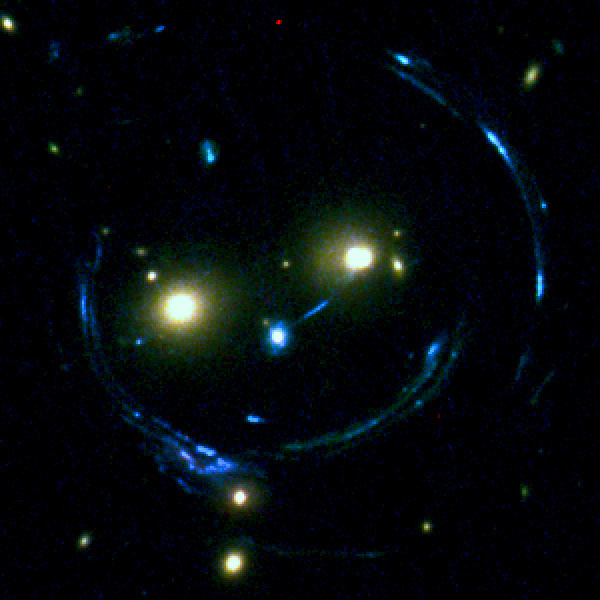
http://www.galaxyzooforum.org/index.php?topic=280292.0 http://www.galaxyzooforum.org/index.php?topic=280292.msg610953#msg610953
Posted
-
 by
c_cld
by
c_cld
SLACS SDSS J0946+1006 -- Gravitational Lens System 1237661065488761132
The first double Einstein Ring, the so-called "The Jackpot Lens".
early-type galaxy at redshift z = 0.222
This ETG is special in that it lenses two sources at different redshifts, creating two nearly complete Einstein rings of different radii. For this reason, the system is also referred to as the “Jackpot”. The first lensed source is at redshift zs1 = 0.609. The redshift of the source corresponding to the outer ring is phot_zs2 = 2.41.
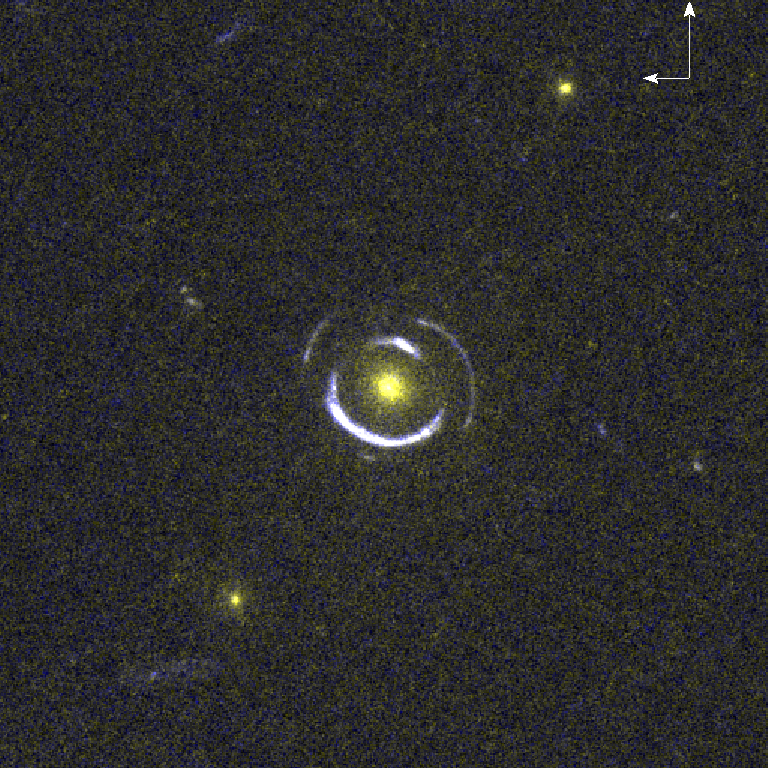
filters images hst_11701_01_wfc3_uvis_f336w & hst_11701_01_wfc3_uvis_f438w
Posted
-
 by
c_cld
by
c_cld
Cheshire Cat in inverted pic to better show the different color of arcs (distinct background lensed sources)
Center RA = 159.68162 Dec = 48.82158 [10:38:43.589 +48:49:17.69]
Composite of filters images:
Red: hst_11974_18_wfpc2_f814w_wf
Green: hst_11974_17_wfpc2_f606w_wf
Blue: hst_11974_16_wfpc2_f450w_wf
and same field from SDSS 1237657628448325814 seen below:
Posted
-
 by
c_cld
by
c_cld
J114833.14+193003.2 COSMIC HORSESHOE
ra,dec 177.13807, 19.50087 R_Einstein 5.1′′ zLens 0.445 zSource 2.379
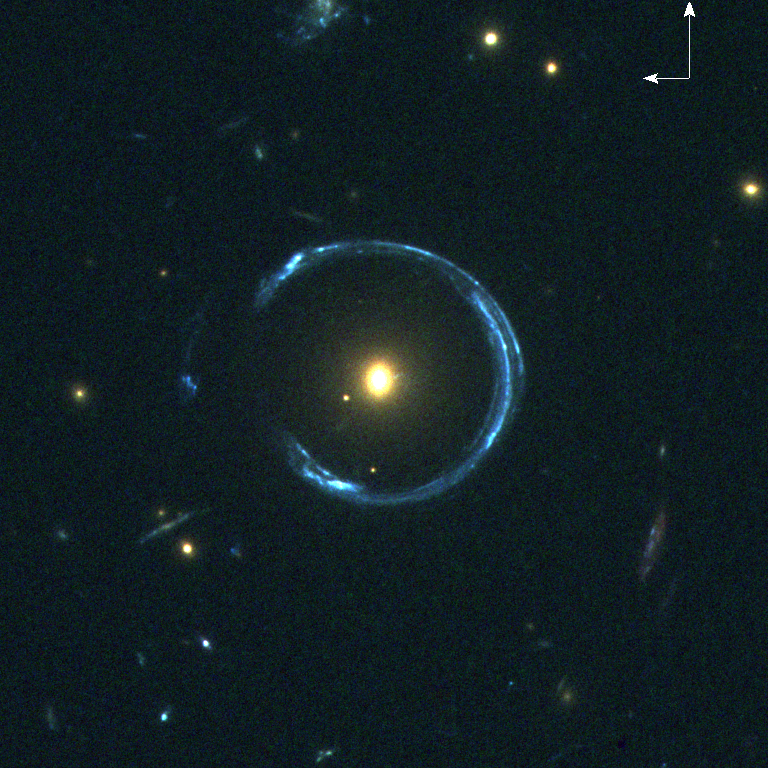 HST WFC3/UVIS
HST WFC3/UVISPosted
-
 by
c_cld
by
c_cld
ra, dec 135.01163, 22.56765 zLens 0.488
SDSS 1237667142864929123
 DES Survey
DES Survey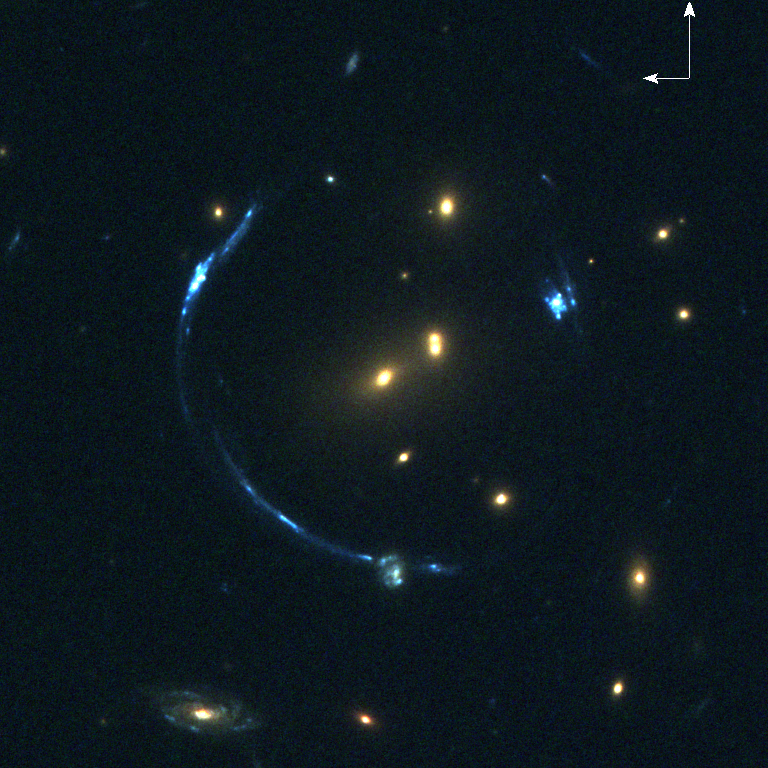 HST WFC3/UVIS
HST WFC3/UVISPosted
-
 by
c_cld
by
c_cld
J014656.00-092952.4 NAME HALL'S ARC
ra,dec 26.73336, -9.49791 zLens 0.447
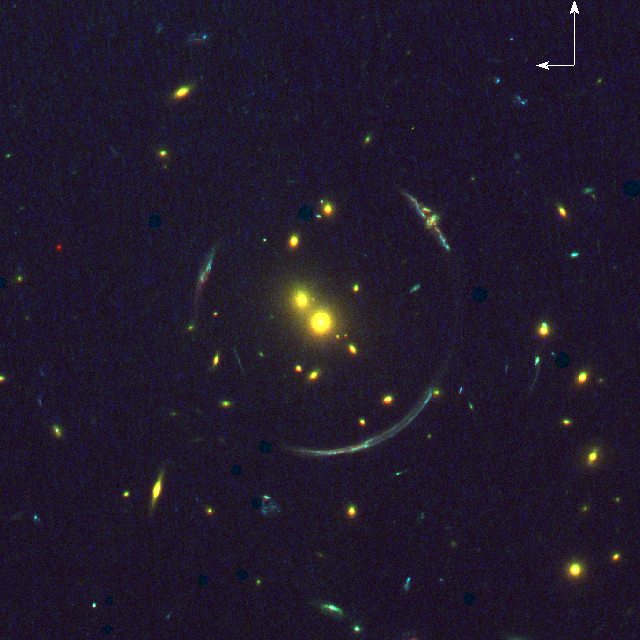 HST wfc3_uvis
HST wfc3_uvisPosted
-
 by
c_cld
by
c_cld
ra,dec 135.34321, 18.24232 zLens 0.346
SDSS 1237667292650864925
 DES Survey
DES Survey HST WFC3/UVIS
HST WFC3/UVISIt seems that an image of background lensed source becomes visible between the two central yellow galaxies! 😃
Posted
-
 by
c_cld
by
c_cld
J120602.08+514229.5 name THE CLONE
ra, dec 181.50871, 51.7082 zLens 0.422
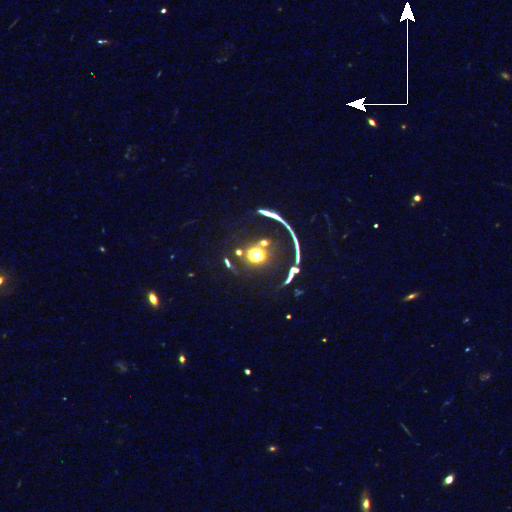 HST wfpc2
HST wfpc2Posted
-
 by
c_cld
by
c_cld
J002240.91+143110.4 nicknamed the “8 o’clock arc”
ra,dec 5.670490 14.51956 zLens = 0.38 zSource = 2.73 R_Einstein = 2.91''
 HST wfpc2
HST wfpc2Posted
-
 by
c_cld
by
c_cld
ra, dec 246.94353, -0.89932 zLens 0.208 zSource 0.524 R_Einstein 1.21"
 HST ACS
HST ACSperfect Einstein ring 😃
Posted
-
 by
c_cld
by
c_cld
ra, dec 217.51704, 41.09921 zLens 0.285 zSource 0.575
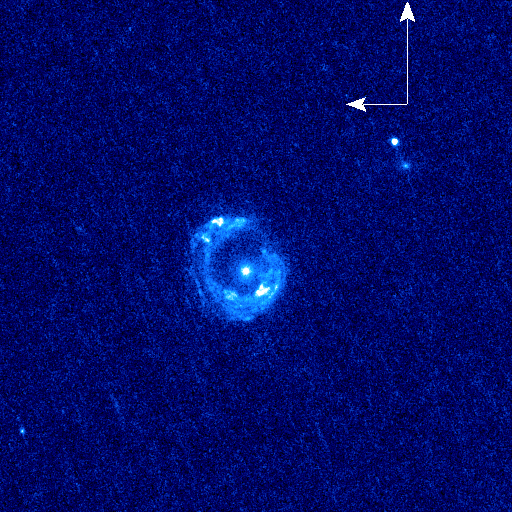 HST WFC3 single filter uvis f390w
HST WFC3 single filter uvis f390wPosted
-
 by
c_cld
by
c_cld
zCOSMOS 850827
SDSS J100050.63+024900.8 ObjId = 587727944570897443
ra, dec 150.211045 2.817191 zLens 0.96
A Strongly Lensed Massive Ultracompact Quiescent Galaxy at z ~ 2.4 , quad in cusp configuration
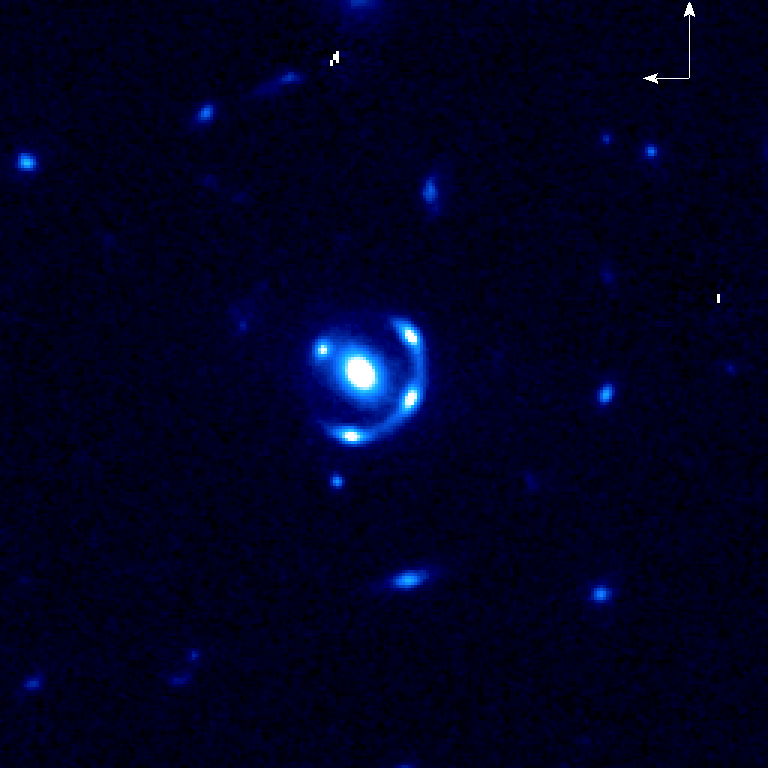 HST wfc3 single filter ir_f160w
HST wfc3 single filter ir_f160wPosted
-
 by
c_cld
by
c_cld
GOODS J033238.22-275653.0
ra,dec 53.159250 -27.948183 Constellation: Fornax
http://www.galaxyzooforum.org/index.php?topic=6927.msg464876#msg464876
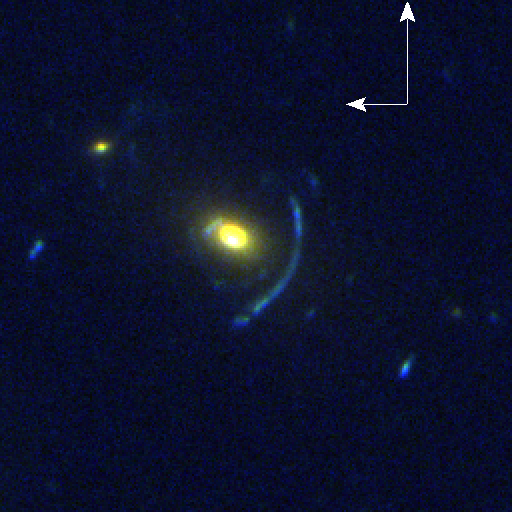
Posted
-
 by
c_cld
by
c_cld
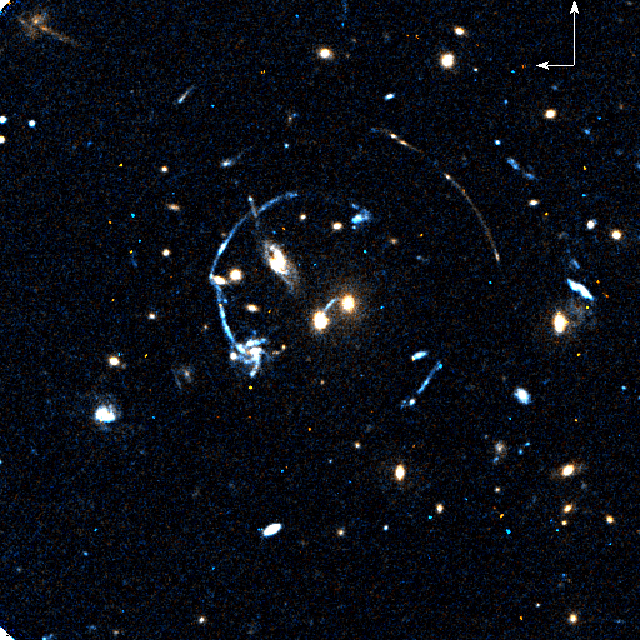 HST wfpc2 Two filters f606w and f814w
HST wfpc2 Two filters f606w and f814wPosted
-
 by
Budgieye
moderator
by
Budgieye
moderator
These are amazing images of arcs in Hubble! Thank you for posting. 😃
I like that last one where you can see hints of green arc in the SDSS image , which are shown clearly in the Hubble image.
Posted
-
 by
JeanTate
in response to C_cld's comment.
by
JeanTate
in response to C_cld's comment.
I second Budgieye's comment; these are amazing images; well done, C_cld! 😃
This particular SDSS image I found particularly interesting: in the thousands of z>~0.25 galaxies I've eyeballed, I'd say I've seen a dozen or so at least somewhat like this. Here's an example (it's SDSS J135040.24+274230.9, and is from this GZ forum post):
How to determine that this - and others like it - are not gravitational lenses?
Posted
-
 by
c_cld
by
c_cld
Thanks Budgieye and Jean for your comments.
I hope it shows you the size and geometry of galaxy-galaxy or galaxy-group lensing along geodesics coming from a smaller universe...
I think most of the eyeballing lenses candidates in SDSS have been discovered and published, like SLACS SDSS J1430+4105 you posted . SDSS is very shallow to determine galaxy-galaxy strong lenses in less than 2" Einstein radius range.
A lot of false positives could be partial or total "ringed" galaxies, collisional galaxies or simply image processing artifacts. The only way to exclude a candidate is by spectroscopy, but of very little opportunity by big telescopes! (example http://talk.spacewarps.org/#/subjects/ASW0000we9, SDSS Id=1237655175470449199)
Posted
-
 by
c_cld
by
c_cld
Looking at cluster ABELL520, found two or three ellipticals lensing candidates (PGC1241888 J045413.12+025734.1 / z(~) 0.225
and PGC1241733 J045414.11+025710.1 / z(~) 0.223 and BOW ACO 520 CC012/ z(~) 0.235) in less than 30" apart.in paper: On Dark Peaks and Missing Mass: A Weak Lensing Mass Reconstruction of the Merging Cluster System Abell 520 Douglas Clowe et al. (10 Sep 2012)
Outside SDSS footprint.
My cutout and composition of HST data:
Red: ACS/WFC CLEAR1L;F814W WFC JBH903010
Green: ACS/WFC F606W;CLEAR2L WFC JBH903030
Blue: ACS/WFC CLEAR1L;F435W WFC JBH903040
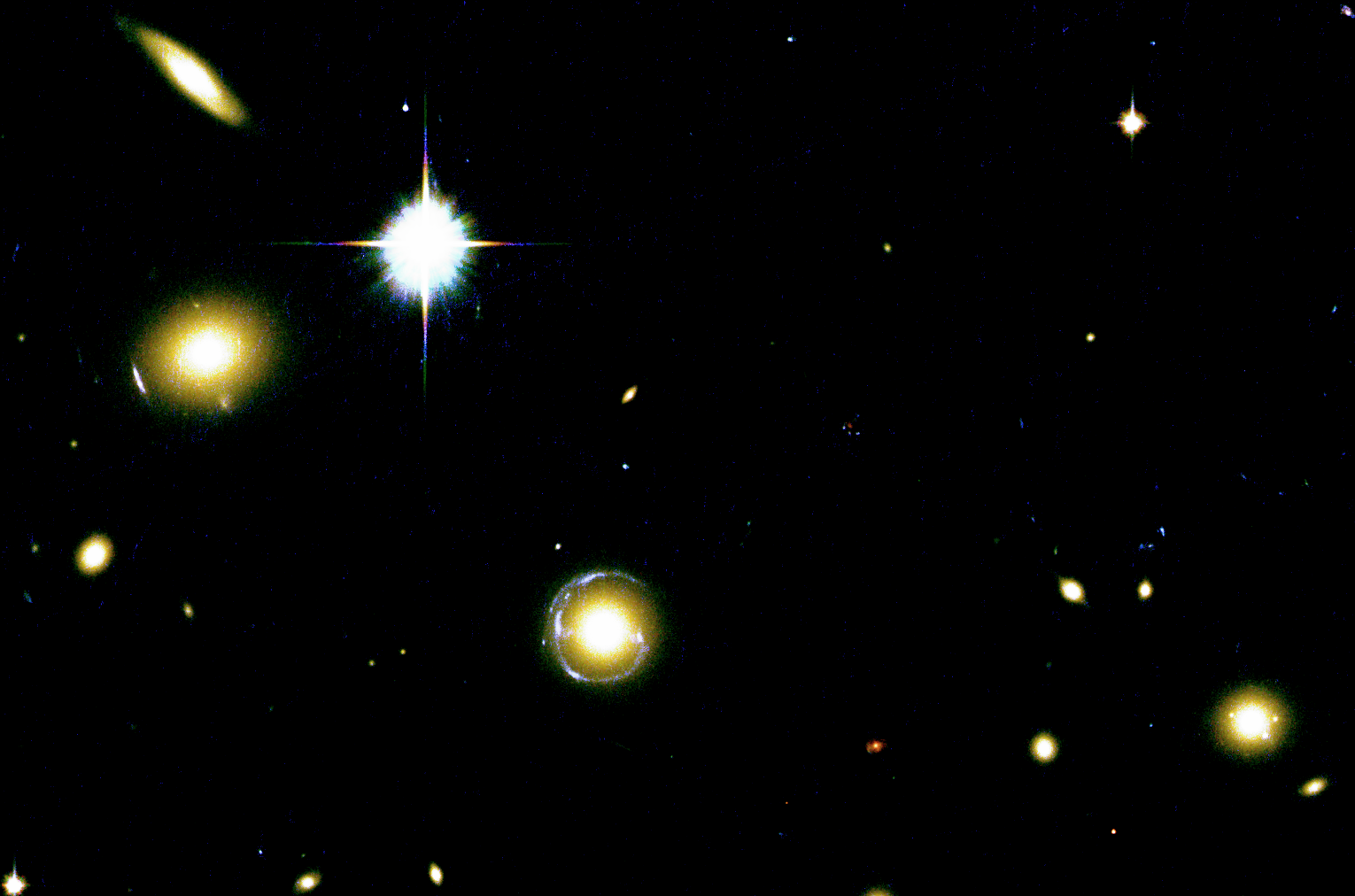 East is ~up and North 95° clockwise from up; width size ~ 1.25 arcmin
East is ~up and North 95° clockwise from up; width size ~ 1.25 arcmin
Would be nice to record them as candidates if they are not already in Master Lens Database by its professional members owners 😃
Cutout with other data WFPC2 F814W WF4-FIX hst_11221_01_wfpc2_f814w_wf
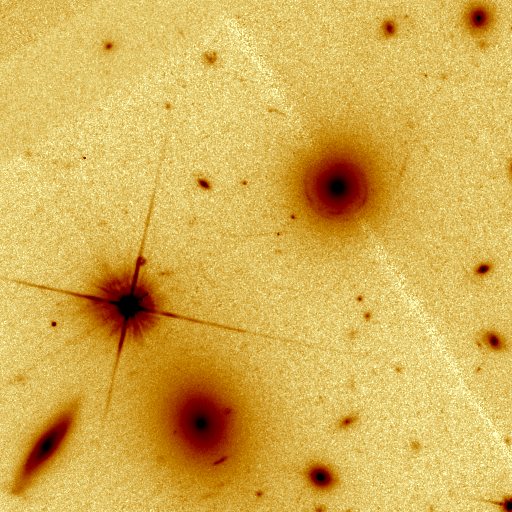 North up; 512 px
North up; 512 pxsingle filter f814w, scale=logarithmic, colormap=bb
Distance between the two ellipticals: 27.36 arcsec
Posted
-
 by
c_cld
by
c_cld
J092115.47+285444.3 A doubly lensed quasar and an inclined quad image of a lensed galaxy;
small-separation 1.9" lensed quasar system z_spec 1.410
 HST observing program 13001
HST observing program 13001Blue: F475W-band (ACS/WFC); Green: F625W (ACS/WFC); Red: F814W (WFC3/UVIS) filters.
Posted